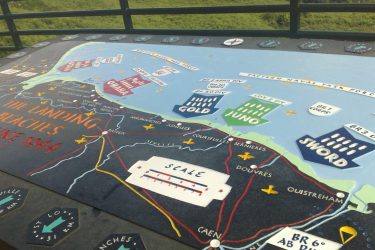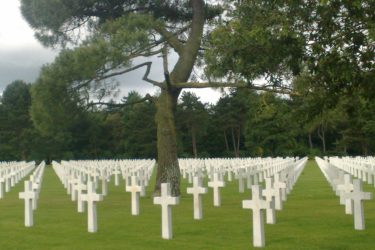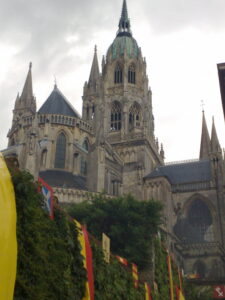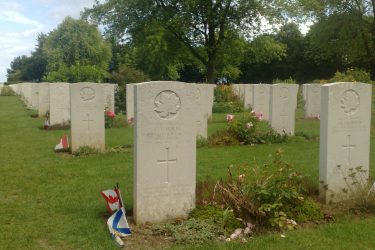Witnessing the D-Day landings in Normandy is a unique experience that immerses you in the history of World War II. The greatest amphibious landing in history took place on June 6, 1944, when Allied forces landed on the beaches of Normandy. The brave warriors who fought and perished there are remembered by the monuments, museums, and cemeteries that today line the shores.
One of the most solemn locations to visit is the American Cemetery and Memorial in Colleville-sur-Mer, which overlooks Omaha Beach. The cemetery is home to about 9,000 American servicemen who lost their lives during the D-Day landings and the events that followed. The memorial also includes an exhibit that details American involvement in the war.
Another important site that is well worth visiting is the Caen Memorial Museum, which provides an extensive history of the war and its consequences on both France and the rest of the world. The museum has exhibits on the causes of the war, the events leading up to D-Day, and the challenges that both troops and civilians encountered during combat. A part on the role of the French Resistance is also included.
Apart from these sites, there are numerous other smaller memorials and museums in the vicinity that provide a more thorough examination of the D-Day events. Visiting these locations is a modest and educational experience that helps us to remember the enormous sacrifices made during World War II. In this article, we will explore some of the D-Day landing tourist sites we think you should visit when you go to Normandy.
Omaha Beach
Omaha Beach is a historic site on the French coast of Normandy. It was one of the five beaches where the Allies conducted their D-Day landings on June 6, 1944, during World War II. The Allied forces found it challenging to land on the beach because of the strong defenses it possessed, including machine guns, barbed wire, explosives, and bunkers.
The Americans were tasked with seizing Omaha Beach, but the German soldiers put up a strong fight. Omaha Beach saw one of the deadliest and most intensive clashes of the D-Day landings. The first waves of American soldiers were met with fierce fire by German defenders perched on the cliffs above the coast. Despite being outnumbered and outgunned, the American soldiers continued to fight their way up the beach, taking over enemy strongpoints one by one.
The landings at Omaha Beach determined the fate of the D-Day invasion as a whole. If the Americans had failed to retain the beachhead, the war might have continued and thousands more lives would have been lost, and the Allies might not have been able to establish a foothold in Europe.
Dedicated to the men who fought and lost their lives there, Omaha Beach is a popular tourist destination today. There are numerous memorials and monuments there. Visiting the beach and its environs serves as a somber reminder of the sacrifices made by the brave warriors who battled to free Europe from Nazi oppression.
Utah Beach
Utah Beach, in Normandy, France, provides an unforgettable look at one of the key locations of the D-Day landings on June 6, 1944. Utah Beach was one of the five beaches where Allied forces landed during Operation Overlord, and it was vital to the invasion of Normandy’s success as well as the liberation of Western Europe from Nazi rule.
Visitors are welcomed by the vast sandy beaches that were the scene of bloody conflicts in the past. The fierce fighting that occurred here is in sharp contrast to the beach’s tranquil beauty now. Because of this contrast, visiting Utah Beach may be both poignant and introspective as one considers the valor and sacrifice made by the warriors who fought here.
A must-see attraction for every trip is the Utah Beach Museum (Musée du Débarquement Utah Beach). The museum, which is situated at the location of the initial landings, provides a thorough rundown of both the D-Day events and the larger background of World War II. Real artefacts, military vehicles, first-hand accounts, and interactive displays are among the exhibits that clearly depict the experiences of the Allied forces. An actual B-26 Marauder bomber serves as one of the museum’s main exhibits, showcasing the scope and intricacy of the airborne operations.
The terrain is dotted with monuments and memorials that pay tribute to the groups and individuals that took part in the landings. The memorial honoring the US 4th Infantry Division, which spearheaded the assault on Utah Beach, is the most notable. These monuments provide a space for introspection and remembering.
Visitors can examine preserved German fortifications and bunkers while strolling down Utah Beach, giving them an understanding of the strong defenses the Allies had to overcome. The educational experience is further enhanced by informative signage and guided tours that provide details about the strategic significance of the beach and the operational difficulties encountered by the Allied forces.
A trip to Utah Beach honors the bravery and tenacity of soldiers who battled for freedom during one of the most important battles in military history and is also a very moving event.
Pointe du Hoc
It is a moving experience to travel back in time to Pointe du Hoc in Normandy, France. It provides a visceral sense of the courage and sacrifice that went into the D-Day landings on June 6, 1944. Because of its steep cliffs and the German artillery positions that endangered the invasion beaches, this strategically important promontory sandwiched between Utah Beach and Omaha Beach was a major goal for the Allied forces.
The most dramatic story of D-Day is the Rangers’ assault of Pointe du Hoc. In order to eliminate the German weapons, the 2nd and 5th Ranger Battalions embarked on a treacherous mission that involved ascending the 100-foot cliffs while under intense enemy fire. Notwithstanding heavy losses, their mission’s accomplishment was essential to the invasion of Normandy’s ultimate success.
Pointe du Hoc is currently under the American Battle Monuments Commission’s management as a protected battlefield. Wander around the bomb-cratered countryside and investigate the remnants of the German gun emplacements and bunkers. The high cliffs serve as a sobering reminder of the difficulties the Rangers faced and are now a site of somber contemplation.
Stopping by the Pointe du Hoc Ranger Monument, perched on a cliff, offers an opportunity to pay tribute to the bravery and selflessness of those who fought there. The granite pylon monument honors all individuals who participated in Operation Overlord and pays tribute to the Rangers who ascended the cliffs.
The Pointe du Hoc interpretive center enhances visitors’ comprehension of the events by providing in-depth exhibits, first-hand recollections, and historical context.
Viewing the English Channel from the cliffs of Pointe du Hoc, tourists are taken back in time to that historic event and are deeply moved by the bravery and tenacity that characterized the D-Day landings.
Sainte-Mère-Église
The small village of Sainte-Mère-Église in Normandy, France, transports visitors to the tumultuous history of World War II, making a visit there an incredibly moving experience. Sainte-Mère-Église, which was among the first towns freed by the Allies on June 6, 1944, during the D-Day invasion, is a unique site in the annals of military history.
The legendary incident involving American paratrooper John Steele of the 82nd Airborne Division becoming stuck on the church spire during the night drop is one of the most well-known tales connected to Sainte-Mère-Église. As a moving reminder of the tumult and bravery of that night, a mannequin with a parachute hangs from the steeple today to honor this occasion.
One of Sainte-Mère-Église’s must-see attractions is the Airborne Museum (Musée Airborne). The museum, which is next to the church, has a large collection of displays that include vintage airplanes, military hardware, and first-hand accounts from troops who participated in the Normandy campaign. Visitors can have an interesting and instructive experience with interactive displays and intricate dioramas that help them comprehend the strategic significance of the airborne operations during D-Day.
Visitors can investigate further historical markers and memorials honoring the Allied forces by strolling about the area. Every aspect of the town provides a window into the past, adding to the town’s tangible feeling of history.
Annual ceremonies and memorial activities are also held at Sainte-Mère-Église, particularly around the anniversary of D-Day, drawing visitors from all over the world who are interested in history as well as veterans and their families. These gatherings provide a special chance to remember the fallen and gain knowledge from individuals who were present during the actual fighting.
Pegasus Bridge
The Pegasus Bridge, a famous building in Normandy, France, was important to the history of World War II. During the German occupation of France, the bridge—which was once known as Bénouville Bridge—served as a crucial strategic site. British airborne troops took control of the bridge during Operation Deadstick, the first action of the D-Day landings, in the early hours of June 6, 1944.
Major John Howard led the glider-arriving men that promptly captured the bridge and held it against fierce German counterattacks. The operation marked a significant turning point in the Normandy landings as it prevented the Germans from launching an effective counterattack and secured the eastern flank of the landing beaches.
The bridge and its surroundings have been restored and made into the Pegasus Memorial Museum in remembrance of the British soldiers who fought and lost their lives during the operation. The museum features artefacts, documents, and exhibits that narrate the events leading up to the bridge’s capture and the velour of the fighting soldiers. Pegasus Bridge is a symbol of the bravery and determination of soldiers who fought in World War I for freedom.
Arromanches
Exploring the history of D-Day and World War II can be profoundly and unforgettable when one visits the small hamlet of Arromanches on the French coast of Normandy. Known for playing a crucial part in the Allied invasion of Normandy on June 6, 1944, Arromanches continues to be a moving and instructive place to visit for both history buffs and casual tourists.
The most notable feature of Arromanches is the remains of Mulberry Harbor, an artificial harbor built by the Allies to speed up the unloading of supplies required for the assault. The enormous concrete caissons, which are still visible to visitors and act as quiet monuments to the wartime effort’s engineering creativity and logistical success, are spread over the beach and in the ocean. The Mulberry Harbor Museum (Musée du Débarquement) provides in-depth displays and models that describe the building and functioning of this amazing engineering achievement.
The town’s gorgeous surroundings and golden dunes stand in stark contrast to the burden of history it carries. It is possible to consider the greatness of the invasion and the valor of the warriors who landed there while strolling along the beaches. In addition to providing expansive vistas, the cliffs above the shore are lined with memorials and plaques honoring the sacrifices made by Allied forces.
The Arromanches 360 Circular Cinema, which is not far from Arromanches, offers an immersive experience with its 360-degree film that tells the tale of the Battle of Normandy using archive video. The scope and severity of the events that occurred in this area are vividly shown in this moving presentation.
Apart from its historical significance, Arromanches has quaint shops, cafes, and restaurants where guests may savior regional fare and hospitality. The town is a singular and enriching experience in Normandy because of its harmonious combination of historical veneration and tranquil seaside beauty.
La Cambe German War Cemetery
La Cambe German War Cemetery in Normandy, France honors German soldiers who fought and died in World War II. Covering an area of around 21.5 hectares, the cemetery is home to the bones of over 21,000 German soldiers. Most of these men lost their lives in the Battle of Normandy in 1944.
The cemetery was created by architect Dieter Oesterlen, and it was inaugurated in 1954. The graves of the soldiers are marked by rows of headstones in a simple, somber cemetery design. The cemetery is surrounded by trees, creating a calm yet melancholy atmosphere.
Jewish soldiers’ graves are designated by black crosses or Stars of David, and each gravestone bears the soldier’s name, rank, and year of death. The primary memorial in the cemetery pays tribute to the departed and has the German inscription, “May all those who find their last resting place here be honored and never forgotten.”
At the La Cambe German War Cemetery, visitors can honor the fallen soldiers and reflect on the tragic circumstances of the war. The cemetery serves as a stark reminder of the horrific human cost of conflict and the need of advancing harmony and peace.
Colleville-sur-Mer in France
The Normandy area of France has the little village of Colleville-sur-Mer. The most well-known monument in the area is the Normandy American Cemetery and Memorial, which was constructed in remembrance of the soldiers who lost their lives during the D-Day landings during World War II. The martyrs’ graves are illuminated by stars of David and numerous rows of white marble crosses, making the cemetery an incredibly beautiful and solemn place.
With only 200 residents, Colleville-sur-Mer is a sleepy village aside from the cemetery. Wandering through the village’s narrow streets, visitors may admire the distinctive Normandy architecture and breath-taking views of the surrounding countryside and sea. Another attraction is the village’s small beach, which is popular with both residents and tourists in the summer.
For those who are interested in World War II and history, Colleville-sur-Mer is a must-visit site. The hamlet of Normandy itself is rich in culture and history, and the Normandy American Cemetery and Memorial is a powerful and moving tribute to the soldiers who fought and died on the Normandy beaches.
Caen, France
Caen, France, provides visitors with a deep and comprehensive understanding of one of the most significant moments of World War II and acts as a moving entryway to the Normandy D-Day landing beaches. Caen, the biggest city in Normandy, is a center for visiting neighboring historical monuments and museums devoted to D-Day and the Battle of Normandy, but it also has its own scars from the war.
The focal point of D-Day tourism is the Caen Memorial (Mémorial de Caen), which features extensive exhibitions that cover the events leading up to and following the Allied invasion of Normandy on June 6, 1944. The museum emphasizes themes of human rights, freedom, and reconciliation while offering in-depth insights into the war’s impact on world history through immersive displays, artefacts, and multimedia presentations.
Tours to neighboring D-Day landing beaches, like Omaha Beach, Utah Beach, and Gold Beach, where Allied forces surged ashore under severe fire, are available from Caen. These beaches are now somber monuments honoring the thousands of troops who gave their lives in defense of freedom. Two moving reminders of the human cost of war and the unbreakable tie between France and its Allied liberators are the Normandy American Cemetery and Memorial at Colleville-sur-Mer and the Juno Beach Centre for Canadian servicemen.
Bény-sur-Mer Canadian War Cemetery
The Bény-sur-Mer Canadian War Cemetery is located in the Calvados region of France and is a somber place. Buried there are 2,049 Canadian soldiers who lost their lives in WWII, mostly during the 1944 D-Day landings. Situated on a hilltop, the cemetery commands a view of Juno Beach, a crucial landing zone during the Normandy invasion.
The headstones in the welcoming cemetery are arranged in rows upon rows and are kept in pristine condition. Most of the graves are marked with the Canadian maple leaf, but there are a few stones with the flags of other Commonwealth nations as well. The peaceful, well-maintained surroundings serve as a poignant reminder of the sacrifice made by so many young men, especially in contrast to the atrocities of war.
The cemetery also has a large number of memorials, one of which is a Cross of Sacrifice that stands out in the vicinity. It is a site of contemplation and remembrance, paying tribute to the courage and selflessness of those who battled and lost their lives for freedom. A somber monument to those who lost their lives defending their country, the Canadian War Cemetery in Bény-sur-Mer serves as a sobering reminder of the cost of war.
In conclusion, The D-Day landing tourist sites in Normandy are a powerful reminder of the bravery and selflessness of the Allied soldiers who fought and lost their lives on the beaches and fields of Normandy. These sites offer a unique opportunity to learn about World War II history and honor those who lost their lives for freedom. Whether you are a history buff, a veteran, or just want to know more about one of the most significant historical events, a trip to Normandy is a must.

















